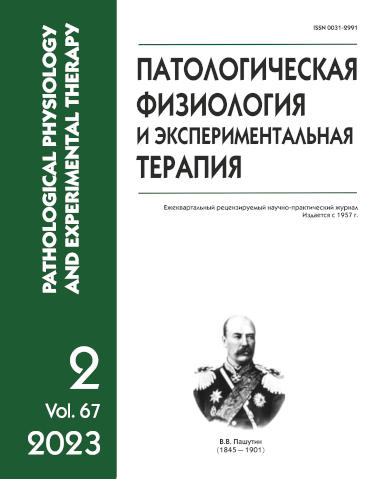Антифибротическое действие фукоксантина при тетрахлорметан-индуцированном фиброзе печени
DOI:
https://doi.org/10.25557/0031-2991.2023.02.86-93Ключевые слова:
фукоксантин, фиброз печени, трансформирующий фактор роста-β, перисинусоидальные клетки печени Ито, миофибробластыАннотация
Несмотря на успехи современной медицины, в настоящее время не существует альтернативы хирургическому методу лечения цирроза печени – трансплантации печени, использование которого в массовой практике затруднительно. Наиболее перспективной стратегией подавления развития фиброза печени является ингибирование канонического пути трансформирующего фактора роста-β, как основного профиброгенного фактора роста, ответственного за стимулирование процессов активации и дифференцировки перисинусоидальных клеток печени Ито в миофибробласты. Цель исследования – изучение эффективности и механизмов действия фукоксантина при фиброзе печени. Методика. Исследования проведены на 50 белых мышах-самцах (возраст 8-10 нед, масса 20-22 г). В экспериментах использовался фукоксантин (10 мг/кг) ежедневно per os, через зонд. Исследование было разделено на 2 этапа: Первый этап – моделирование тетрахлорметан-индуцированного фиброза печени. Было выделено 3 группы по 10 животных в каждой: группа интактных животных; опытная группа, которая получала 25% раствор тетрахлорметана (2 мкл/г) на персиковом масле внутрибрюшинно; группа контроля, которая получала персиковое масло в эквивалентных дозах. Второй этап – изучение эффективности и механизмов действия фукоксантина при фиброзе печени. Было выделено 2 группы животных с фиброзом печени: группа сравнения (n=10), которой не проводилось лечение и основная группа, которой вводили фукоксантин (10 мг/кг, n=10) в течение 5 нед. Выраженность фиброза печени оценивалась по шкале METAVIR. Методом ИФА в гомогенате печени исследовали уровень трансформирующего фактора роста-β. Иммуногистохимически оценивали количество α-SMA+ клеток, определяли уровень тканевого ингибитора матриксных металлопротеиназ-1 (TIMP1), матриксных металлопротеиназ-9 и -13. Для оценки степени замещения паренхимы печени соединительной тканью использовалось окрашивание Sirius Red. Результаты. Было установлено, что фукоксантин в дозе 10 мг/кг обладает антифибротическим действием, которое реализуется через ингибирование основного профиброгенного фактора TGF-β. Следствием снижения уровня TGF-β было уменьшение количества миофибробластов, TIMP-1 и объема соединительной ткани в печени. Заключение. Фукоксантин можно рассматривать как перспективный препарат для лечения фиброза печени.Загрузки
Опубликован
2023-06-27
Выпуск
Раздел
Оригинальные исследования
Как цитировать
[1]
2023. Антифибротическое действие фукоксантина при тетрахлорметан-индуцированном фиброзе печени. Патологическая физиология и экспериментальная терапия. 67, 2 (Jun. 2023), 86–93. DOI:https://doi.org/10.25557/0031-2991.2023.02.86-93.













